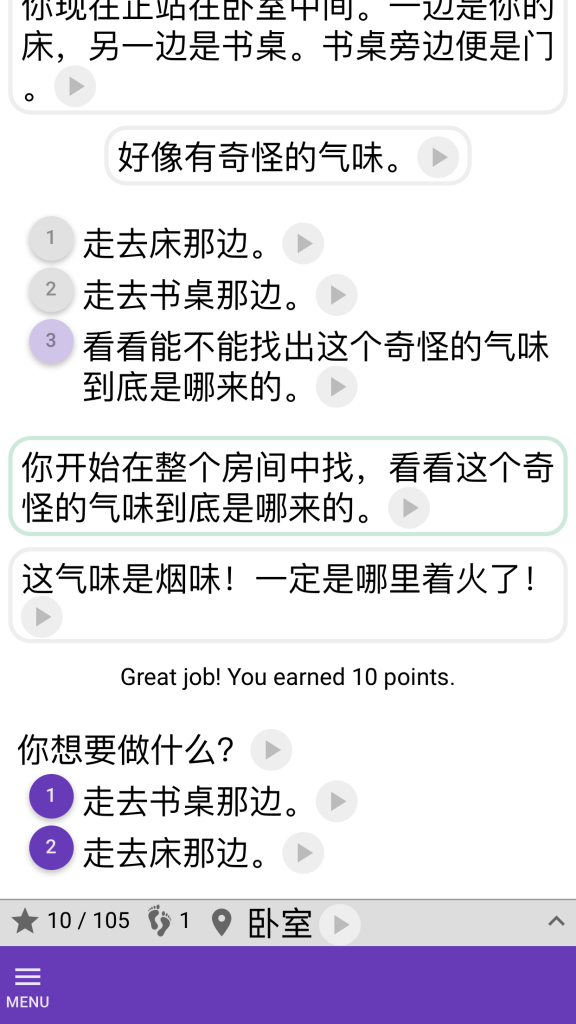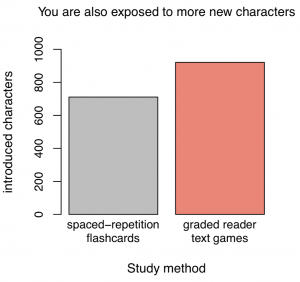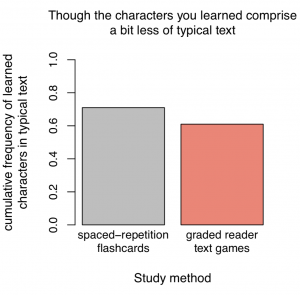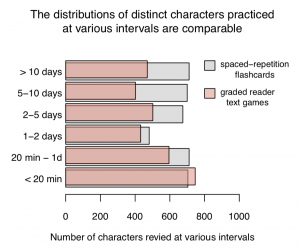Learning vocabulary is one of the most time-consuming parts of mastering a language. There are some tools that can help you, such as spaced repetition software, but plain reading can also be great, especially if the content is engaging and the difficulty is just right. In this guest article, Kevin Bullaughey compares spaced repetition software with reading level-adjusted stories, in this case the adventure text games he and I have created over at WordSwing. Enjoy!
Reading is a lot like spaced repetition, only better
A central question in strategizing how to learn a language is how to best allocate your study time?
There are numerous ways to practice, including conversation, flashcards, watching movies, reading, audio courses, and more. For some of theses activities, like flashcards, you could always spend more time, while others are limited by your circumstances, such as conversation opportunities.
Both reading and flashcards fall into the category of something you could always spend more time doing. But how should we weigh whether to allocate more or less time to these activities? And what if reading, such as reading while playing games like we discuss later, is a lot more fun than flashcards? How do we balance that with any efficiency or efficacy benefits of flashcards?
Because our goal is to strategize about optimal learning, let’s think about each of reading and flashcards in fairly optimal forms. For reading, this amounts to reading engaging, ability-appropriate material, and for flashcards this amounts to reviewing cards using the principles of spaced repetition.
Spaced repetition for learning Chinese vocabulary
Spaced repetition is a strategy for reviewing vocabulary that uses increasingly long intervals between reviews of a word as you learn it better and better. The idea is that, as you know something better, you can remember it for longer periods of time without seeing it again.
This has two benefits:
- You don’t waste time reviewing things you know, while simultaneously ensuring you review the new stuff before you forget it.
- Perhaps the act of recall after not seeing something for a long time actually results in a brain recall process that is more effective at encoding the memory. Some of the most popular algorithms (like the one in Anki) use exponentially longer review intervals, say, by doubling the review intervals as you learn a word better.
From the memory and cognition literature, it’s clear that spaced repetition is an effective way to to learn things, but the jury is still out on how important the precise timing parameters are, as these don’t seem to hugely affect outcomes (see e.g. Carpenter & DeLosh, 2005, and Karpicke & Roediger III, 2007).
Although reading and flashcards seem to be very different modes of practice, I hope here to persuade you that reading actually has a lot in common with spaced repetition, sharing many of its most important benefits, in addition to offering many benefits of its own. Additionally, I attempt to compare the relative efficiency of reading and flashcards so we can get to the central question of how should we allocate our time?
How is reading like spaced repetition?
There are several steps to learning a Chinese word. These include:
- Learning the basic meaning of the word.
- Broadening one’s understanding to encompass the various ways the word can and cannot be used, and what connotations it has.
- Remembering the word long enough to use it or recognize it again, thereby creating the opportunity for it to become a functional part of your vocabulary.
- Storing the memory of the word in your brain long term (months or years).
Learning vocabulary through flashcards is mostly concerned with learning the basic meaning (#1), and the spaced repetitions help greatly with medium and long-term memory (#3 and #4).
On the other hand, reading or listening to longer content like sentences and paragraphs, is especially helpful for developing a much fuller understanding of words and how to use them (#2). But reading, like many activities, is also actually a form of spaced repetition. Instead of an algorithm controlling the timing intervals, the spacing between occurrences of a word is an incidental result of what is written. Thus reading is excellent for the memory aspects of learning too (#3 and #4).
Suppose you see a new word like 上网 (shàngwǎng), which means to go online. Perhaps you know the character 上 but not the character 网, which means net or web. The character 网 happens to occur about 3 times out of every 10,000 characters. But if you’re on the topic of the Internet you might see 网 again much sooner (i.e., after a short review interval). Perhaps you see it next in the word 网路 (wǎnglù), which means Internet. Much later, if you’re reading something else, perhaps you encounter 蜘蛛网 (zhīzhūwǎng), which means spider web. This delay would correspond to a long review interval. These are the natural timing dynamics of language, but the result is that normal reading shares timing characteristics with spaced-repetition, at least at a coarse level.
Perhaps this shouldn’t be too surprising. Our brains evolved in an environment where our experiences were not organized into precisely increasing exponential intervals. That’s not to say pure spaced repetition might not be more efficient per review, but we must not ignore another hugely important factor: the total number of reviews. During the course of reading you are likely to encounter vastly more words per minute than you are if you’re turning flashcards one at a time.
Simulating learning vocabulary through reading and spaced repetition
Our goal here is to understand how learning Chinese vocabulary through reading compares to using flashcards. I am mainly concerned with how efficient the process is. Can you learn more words per unit time by reading or using flashcards? And how do the two methods compare for long-term retention? Here, I don’t treat learning to write words or how to remember this long-term, instead I focus just on learning and remembering meaning.
 To make things concrete, I will use the content from the text adventure games we have developed at WordSwing. These games are aimed at intermediate students of Chinese and are a bit like interactive graded readers. That is, the material is written to specifically exclude difficult vocabulary and limit the overall number of words (see screenshot on the right).
To make things concrete, I will use the content from the text adventure games we have developed at WordSwing. These games are aimed at intermediate students of Chinese and are a bit like interactive graded readers. That is, the material is written to specifically exclude difficult vocabulary and limit the overall number of words (see screenshot on the right).
In these games you make choices such as “climb out the window”, or “bargain for a cheaper price,” that affect the subsequent course of the game. Thus, these games are also a bit like text-based role-playing games.
If you want to try a game to see what it’s like, you can try Escape for free here.
One of our missions at WordSwing is to use WordSwing itself as a platform to improve language learning, through content, tooling, personalization, and experiments about how students learn. We have a great deal of data from the thousands of students who use WordSwing to learn. And so the starting point for these simulations is actual transcripts of what students read while progressing through our text adventure games. As much as possible we set up our analysis in a way that reflects actual WordSwing study behavior.
Reading vs. spaced repetition
To compare reading to flashcards, we try and stack the deck, so to speak, in favor of spaced repetition, even if this is overly optimistic. That way, if we reach a conclusion that paints reading in a favorable light, we know it should be quite robust. We keep the overall study time and schedule the same as well as use similar metrics for what it means to learn a character.
The table below gives the assumptions we made in conducting these simulations.
| Graded reading – Text adventure games | Spaced repetition – Flashcards |
| Sample actual game transcripts from WordSwing student historical data. | Build word list of 1400 words from the games, excluding very common ones and introduce words in frequency order. We use WordSwing’s spaced-repetition algorithm, which is similar to Anki. |
| Total 15 hours of study broken into 20 minutes per day, taking a day off per week. | (same) |
| Assume students read 57 characters/minute, which is based on our observed data. | Review 8 flashcards per minute. |
| More than 51,000 characters of Chinese text | More than 6300 flashcard reviews. |
| Suppose learning a character requires seeing it twice on the same day, and at least 10 more times across at least 5 additional days. | Suppose learning a character involves reviewing it 10 times at exponentially increasing intervals (10th interval ~2 months) |
Results
Through these simulations, we start to get a picture of whether the natural spacing of characters in our text adventure games is comparable to explicit spaced repetition using flashcards, and how well this might translate into how many characters you are likely to learn and remember.
Result 1: You are likely to learn more characters through reading than a comparable amount of flashcard study.
 A large part of this result is that you end up being introduced to more characters overall (~900 by playing games vs ~700 by studying flashcards). And given our games often involve seeing the same words a bunch of times, you can learn perhaps about 100 more characters over the 15 hours than if you studied the same words via flashcards.
A large part of this result is that you end up being introduced to more characters overall (~900 by playing games vs ~700 by studying flashcards). And given our games often involve seeing the same words a bunch of times, you can learn perhaps about 100 more characters over the 15 hours than if you studied the same words via flashcards.
Result 2: The characters you learn comprise a bit less of typical text.
 With flashcards, you can control the order in which you learn the words. And so we set the experiment up to learn the words in descending frequency order (most common first). Not surprisingly, if we tabulate the fraction of typical text that is composed of these characters, we find that learning through flashcards means you’ll be able to read a larger percent of what you see. But it’s worth noting that learning through reading is not far behind. The difference is explained by a few common words that don’t occur much in the games, and so you miss these.
With flashcards, you can control the order in which you learn the words. And so we set the experiment up to learn the words in descending frequency order (most common first). Not surprisingly, if we tabulate the fraction of typical text that is composed of these characters, we find that learning through flashcards means you’ll be able to read a larger percent of what you see. But it’s worth noting that learning through reading is not far behind. The difference is explained by a few common words that don’t occur much in the games, and so you miss these.
Result 3: How many times you review each character at each spacing is similar between spaced repetition and the text games.
 That is to say, reading is a lot like spaced repetition. If you see a new character, it’s likely you’ll see it again shortly, and then after that you’ll see the character at a variety of spacing intervals, which will help your brain solidify the memory.
That is to say, reading is a lot like spaced repetition. If you see a new character, it’s likely you’ll see it again shortly, and then after that you’ll see the character at a variety of spacing intervals, which will help your brain solidify the memory.
Conclusion
The title of this article pretty much says it all: reading is a lot like spaced repetition, only better.
Not only does reading share many of the timing dynamics of spaced repetition, it likely even results in more overall learning due to the much higher volume of material you can read compared to spaced repetition. And! Reading allows you to encounter the words in a variety of contexts, fostering a more developed understanding of the word’s meaning and how it’s used. Learning words in context may even be more effective per encounter.
Plus, reading can be a lot more fun than flashcards, particularly if it’s playing games like WordSwing’s text adventure games used in this analysis. If you haven’t tried any of them yet, you can play the game Escape for free here.
Our comparison assumed you’d spend the same amount of time on flashcards vs playing the games. But judging from our students, we know they spend a lot more time playing games, than studying flashcards. And these are just the benefits of reading for learning vocabulary; reading also helps learning a language in many other important ways that go beyond our focus in this article.
That said, I think there is a place for both flashcard-based review and reading. When your vocabulary is rapidly expanding into the increasingly rare words, you may find yourself forgetting many of these by the time you see them again, even after you’ve managed to remember it for many days. Plus, flashcards allow you to practice more types of active recall (remembering the word given a definition, remembering how to write it, etc.). Keeping a healthy spaced repetition habit can greatly help you keep these words in your memory. But it takes a lot of dedication. And it’s easy for a flashcard queue to get unmanageably large and intimidating.
Related content on Hacking Chinese
- Spaced repetition software and why you should use it
- If you think spaced repetition software is a panacea you are wrong
- Five text games for Chinese learners
- Into the Haze: A new text adventure game for Chinese learners
Further reading
Carpenter, S. K., & DeLosh, E. L. (2005). Application of the testing and spacing effects to name learning. Accessible online here.
Karpicke, J. D., & Roediger III, H. L. (2007). Expanding retrieval practice promotes short-term retention, but equally spaced retrieval enhances long-term retention. Accessible online here.


6 comments
Olle, thank you for this wonderful treasure trove of a website, and thank both you and Kevin for the text games at WordSwing. I’ve enjoyed them quite a bit, and indeed they add quite some flavor to my learning and helped broaden my vocabulary :).
I actually had a question for you, Olle, regarding the e-mail you sent to introduce this article (and would be happy to hear Kevin’s thoughts too if he’s lurking):
“””
What’s your take on this? Are you sacrificing reading and listening because you feel you have to go through a pile of flashcards? I know there have been periods where I have felt like that, but I’m curious what you think!
“””
Do you think you have a “priority” for what things you need to study? For me, I often have about 2 hours of time spread throughout the day (listening to podcasts or reading flashcards during my commute, some phone-reading during lunch, study time at night)… but I always feel pressure to get the flashcards finished before getting to sleep. “If I don’t, there will be a lot more tomorrow, etc etc.” So even if I’d rather get a bit further in a WordSwing game or in a textbook lesson, I feel like for my flashcard-sanity I need to “pay that down” (even though it is fun most of the time :).
And a related question: how did you handle periods where you felt overwhelmed by flashcards? (Cut off new cards for a while? Delete cards? Maybe there’s already an article on this somewhere 🙂
I actually wrote an article specifically about being overwhelmed by vocabulary! Check it out: https://www.hackingchinese.com/overcoming-problem-many-chinese-words-learn/
Such an informative blog on reading chinese that will help students in an enormous way, Thanks to the author who took Mandarin serious and interesting.
Ok, it’s 2am and you’ve caught my attention with wordswing.
I think I shall spend some more time on it tomorrow.
Sounds good! Let me know what you think about it after you’ve tried it.
I don’t totally understand this reading vs SRS. Spaced repetition is one of many tools to support my learning, reading is doing and using the language. Much more the real thing. So I always have to read and cannot do SRS in isolation, but always have to see it in the context of other learning. I see SRC less as an independent learning, but more as an organization of learning to sort out what I have to review or learn again and to take track of knowledge. So the question is more, how to allocate time, to use the extra 5 minutes. Perhaps with ESCAPE, i’ll try it.